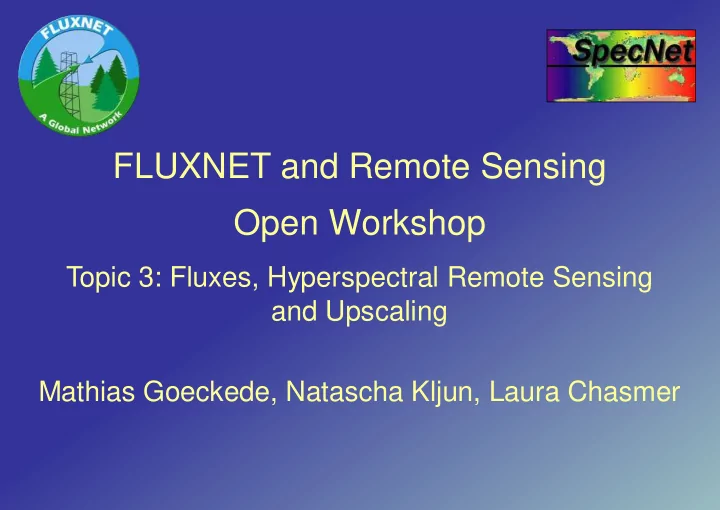

FLUXNET and Remote Sensing Open Workshop Topic 3: Fluxes, Hyperspectral Remote Sensing and Upscaling Mathias Goeckede, Natascha Kljun, Laura Chasmer
Integrating footprints into FLUXNET database Requirements • Find compromise between model accuracy, processing time (1000+ site years) and input data availability • Provide both simple footprint metrics (e.g. basic dimensions) and detailed results (e.g. full source weight function) for customized in-depth studies • Offer options for more intensive footprint analyses, e.g. more sophisticated models for sites with extended datasets
Integrating footprints into FLUXNET database Focus on 2-3 models (suggestions: Hsieh et al., Kljun et al.) that are comparatively easy to handle, yet accurate and flexible Add ‘simple’ metrics as additional columns to database: • Position of source weight maximum • Characteristic dimensions of source weight function (e.g. maximum alongwind distance of 80% effect level) • Flux contribution percentage from target land use type These are intended to give a quick insight into potential data problems related to heterogeneous land cover in the fetch
Integrating footprints into FLUXNET database Store full source weight function to offer interested user the option to run customized analyses Additional requirement: Software tool that allows to overlay footprints with remote sensing data layers in different formats - > Each user can define how to define ‘heterogeneous’, e.g. user a multi-layer analysis including land cover type, LAI, stand height, topography, etc
Data requirements for bridging the scales between towers and RS Fluxnet Community: Requirement of data from fluxnet community to derive footprints (e.g. prevailing wind directions, high frequency (sigma) values, Monin Obukov length). Remote Sensing Community : Requires information on site heterogeneity, wind direction Put together high-resolution remote sensing datasets at each site to help with both scaling and quality control of tower data This information should be included in the ORNL DAAC and fluxnet websites
Remote sensing products to describe site characteristics What key metrics are required to capture the main factors that determine heterogeneous flux fields for different ecosystems (e.g. peatland , forest, desert…) ? • Soil moisture? • LAI? • Vertical stand structure (LIDAR data)? Are these data layers available for all sites?
Database for footprint model development and evaluation What datasets are (publicly) available that allow for footprint model evaluation? • Artificial and natural tracer experiments • Multi-tower observations across flux gradients Identify a subset of sites that provide additional data on e.g. • Boundary layer height • Vertically resolved turbulence structure
Cost/benefit analysis for different footprint model versions Wide range of models available (simple analytic to Accuracy complex LES) Need to define investment (processing time, input data, etc) Need to define accuracy Investment (benchmarking system?)
Summary • Collection of input parameters for detailed footprint analyses in FLUXNET database • Creation of a footprint information webpage on fluxdata.org • Additional information on site heterogeneity as ancillary data in FLUXNET database • Input from SpecNet on additional remote sensing products for footprint studies • Have these tools / data available for upscaling exercises
Recommend
More recommend